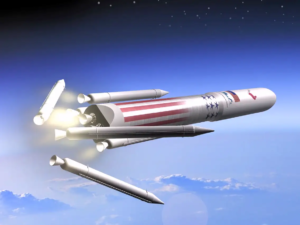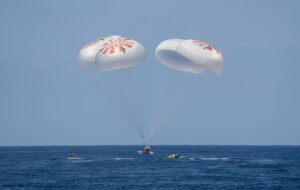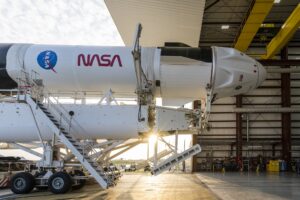
How India Just Successfully Landed On The Moon
Last month on July 14th, the Indian Space Research Organization (ISRO) launched its third lunar exploration mission. Named Chandrayaan-3, this mission featured a very similar goal and even hardware as the agency’s previous lunar mission, which crashed into the Moon. Thankfully, this time around, the lander managed to safely touchdown on the surface as planned.
Specifically, the lander touched down in the vicinity of the lunar South Pole region at 8:32 a.m. Eastern time, following a 19-minute descent from lunar orbit. This success means that India joins the United States, China, and the former Soviet Union in successfully soft landing on the moon. A significant milestone and especially impressive when considering the low budget of this mission.
Only days ago Russia’s Luna 25 lander crashed into the Moon after issues arose related to an engine burn. This helps put in perspective how difficult this achievement is and what it means for the future. Here I will go more in-depth into the successful landing, the journey from the Earth to the Moon, what’s next, and more.
Chandrayaan-3 Lands

Initially, after the successful launch, they gradually raised the lander’s orbit before making a burn on July 31 that set it on course for the moon. For the next 5 days, the lander named Vikram traveled through space before entering lunar orbit on the 5th. At that point, the ISRO released the images showing that the spacecraft had reached its destination ahead of a lunar landing attempt expected on Aug. 23. After reaching lunar orbit, the lander was still utilizing a propulsion module to help conduct engine burns that brought it into a circular track about 60 miles (100 kilometers) above the surface of the moon a week ahead of the expected landing attempt.
This was until August 17th, when after a series of Lunar Bound Maneuvers, the lander separated from the propulsion module, to begin its last phase of the mission to land on the lunar surface. “The rover’s target landing zone spaned four by 2.5 kilometers. ISRO scientists and engineers divided it into 3,900 equal-sized subsections, meticulously assessed the safety level of each for a landing and loaded it into the lander as reference information,” the director of ISRO’s Space Applications Center said. Here, the lander must have taken one of these two decisions: If it found itself above this predetermined landing zone, the onboard computer would have identified the safest feasible subsection area, then accordingly proceeded toward touchdown. If it found itself elsewhere, it would have proceeded with an autonomous landing based on self-identified hazards from its imagery instead of the preprogrammed subsection-based landing.
During the final “terminal descent” phase, the rover lowered itself to about 150 meters above the surface and then hovered again for about half a minute to assess the area below for landing hazards. At this point, since the surface right below the lander didn’t look safe, the lander sought a safer adjacent area and deviated to touchdown there.
We then saw the final decent and soft touchdown on the Moon. Video from the Indian Space Research Organization’s (ISRO) Mission Operations Complex following the successful landing showcased this process. Not to mention the Indian Prime Minister declared just moments after the landing that, “India is on the moon.”
The lander touched down at 69.37 degrees south latitude and 32.35 degrees east longitude, in a relatively flat area surrounded by craters. This landing was made at the highest latitude of any spacecraft to soft land on the moon. The descent was supported by ESA’s ESTRACK deep space tracking station in Australia. This provided additional tracking support during the lunar landing, serving as a back-up for ISRO’s own ground station. The lander also managed to establish contact with the previous mission’s orbiter, which has been circling the moon since 2019 and will serve as the critical communication link with Earth for the rest of this mission.
This mission was India’s second try at landing near the moon’s south pole, somewhat of an uncharted region of immense interest to scientists and exploration advocates alike. The south polar region is thought to harbor large amounts of water ice, which, if accessible, could be mined for rocket fuel and life support for future crewed missions. The country’s first attempt at a lunar touchdown, in September 2019, failed when the lander crashed into the moon due to a software glitch. Impressively, after this mishap, India managed to get the next lander ready on a tight budget of around $75 million.
As far as what changed, the director of the Physical Research Laboratory (PRL) in India commented that India’s success today can be attributed to “extensive changes” to its landing strategy after the previous crash. Onboard algorithms that calculate spacecraft speed in real time during descent were reworked to allow for “more freedom to deviate” from protocol “but still do the landing,” he added. Other changes that helped facilitate the mission’s success include a larger target landing zone, stronger legs for Vikram to withstand higher landing speeds and dynamic engines that adjusted the spacecraft’s velocity for a smoother touchdown.
Between 2019 and today, the ISRO also gained a lot more information on the landing site. Images of the moon that the agency’s orbiter has been sending home since 2019 also painted a clearer picture of the landing site than what scientists knew previously. “There is not much of a hurdle in this [landing] area,” he said. While the successful landing marks a major milestone not only for India but the entire space industry, this is only the start of this mission.
Future Operations

With the lander now safely touched down on the Moon’s surface, the real mission can start. Inside the Vikram lander is a small rover. Soon this rover is expected to roll onto the lunar surface and start analyzing lunar soil and rocks. As an interesting feature, the wheels of this rover are etched with a religious symbol of a wheel with 24 spokes depicted on the Indian flag, and ISRO’s logo. So when the rover inches along on the moon, ISRO hopes both symbols will be stamped onto the surface, where they will remain untouched for many years.
In terms of actual science, the lander is equipped to sense moonquakes near the landing site using an onboard seismometer, and to probe lunar soil to record its temperature. A Probe will also estimate the plasma density and its variations. The rover features two main instruments hoping to gather valuable data. One is the Alpha Particle X-Ray Spectrometer (APXS) which will derive the chemical composition and infer the mineralogical composition of the lunar surface. The other instrument is the Laser Induced Breakdown Spectroscope (LIBS) which will determine the elemental composition of lunar soil and rocks around the lunar landing site. Together, this data will help both the ISRO as they work on their own future missions and also other agencies around the globe.
In June for example, India signed NASA’s Artemis Accords to partner with participating nations on space exploration. NASA is also set to provide advanced training to Indian astronauts at the Johnson Space Center in Houston and send them to the International Space Station next year. Further, ISRO and NASA are also working closely to launch a low-Earth observatory (LEO) in 2024 to map the entire planet in 12 days and offer consistent data for analyzing alterations in Earth’s ecosystems, ice mass, vegetation biomass, sea level, and natural disasters and hazards.
The solar-powered lander and rover will have about two weeks to study their surroundings once the sun sets on the lunar south pole. They are not designed to survive the chilly lunar night. The rover can only communicate with the lander, which communicates directly with Earth. ISRO says the Chandrayaan-2 orbiter can also be used as a contingency communications relay. The goal however is to gain as much information as possible before it everutally stops operating.
In recent years, we have seen a lot of new interest from agencies around the world in reaching the Moon and the south polar region in particular. The lunar south pole features a region with crater rims exposed to near constant solar illumination, yet the interior of the craters are permanently shaded from sunlight. Not only does the light offer unique benefits, but the area also features cold traps. Cold traps are some of the important places in the lunar south pole region in terms of possible water ice and other volatile deposits. Cold traps can contain water and ice that were originally from comets, meteorites and solar wind-induced iron reduction. From experiments and sample readings, scientists were able to confirm that cold traps do contain ice.
In the near future, more countries and private entities could soon join India. Japan is set to launch its Smart Lander for Investigating Moon (SLIM) mission on a H-IIA rocket at 8:34 p.m. Eastern Aug. 25. Intuitive Machines plans to launch its IM-1 on a Falcon 9 later this year as part of NASA’s Commercial Lunar Payload Services (CLPS) program. Even Astrobotic Technology’s Mission One, also part of CLPS, could launch before the end of the year on a ULA Vulcan Centaur rocket. Missions we can look forward to in the coming months and years.
Conclusion
India just managed to successfully land on the Lunar South Pole of the Moon. After an over month long journey, today the lander slowed and descended before touching down on the surface in great condition. In the next few days, we can expect science operations as India prepares to deploy its rover and other science experiments. We will have to wait and see how it progresses and the impact it has on the space industry.



